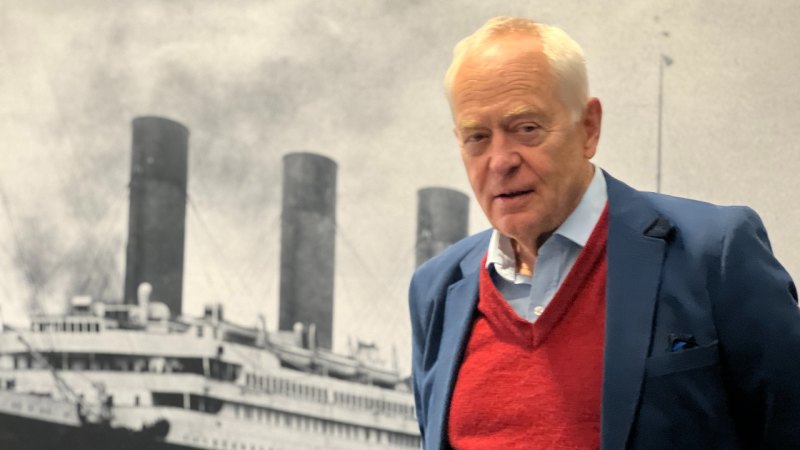Claes-Goran Wetterholm upwraps a layer of white tissue paper to reveal a black leather pocketbook, worn by age. “This is the wallet from a third-class passenger, Mauritz Adahl,” he says. “He was on his way to New York because he had bought land, a plot beside his parents’ farmstead, and he was going to build a house for himself and the family.
“The wallet was found on his body. I met the family in 1987. And one of the granddaughters said: ‘Mother’s greatest wish was to go to Halifax and put flowers on Grandfather’s grave.

’ I just said, ‘well I’m sorry, but there is no grave.’ And this was a shock to them.” Like most of the third-class victims of the Titanic disaster whose bodies were found in the water, Adahl was buried at sea.
First- and second-class passengers were given priority for land burials. “I said to the family, if I ever get the chance I promise I will put flowers on your grandfather’s grave. So in 1994, I brought a wreath from Sweden out to the Titanic [site] and we had a ceremony there on the boat the first night in memory of Mauritz Adahl and in memory of his fellow travellers.
” Wetterholm is a tall, slim, white-haired Swede in his 70s. He has something of the appearance, voice and gravitas of the late actor Max von Sydow. In Brisbane to help with the installation of Titanic: The Human Story , a commercial exhibition at Uptown (formerly the Myer Centre), he is one of the world’s foremost experts on the Titanic; he has written more than 20 books on the topic.
“When I was eight years old,” he says, “my grandmother told me that she was standing in the city of Stockholm in front of a news kiosk with loads of other people [in 1912], and they kept changing the headlines, and suddenly everybody understood what had happened. And it was like a shock wave that went through the throng of people. “Although 50 years had passed when she told me, she was still under such a shock.
” A television documentary further piqued his interest, and he worked on his first Titanic exhibition in 1983, becoming a full-time Titanic scholar in 1996. Titanic: The Human Story is sombrely entertaining and extraordinarily detailed – a deep dive, if you will, into the boat, its passengers and crew, and the society that produced it. “I usually say that everything we knew then of the whole world actually went down with the Titanic,” Wetterholm notes.
On its fateful maiden voyage, Titanic carried 2200 people, well under its capacity of 3547 – a terrible tragedy could have been even worse. It’s believed 1496 perished. “It’s a figure that has been under scrutiny for a long time.
I had 1495, until we discovered there was a waiter in the ship’s a la carte restaurant.” Narrated by an audioguide, the exhibition has genuine Titanic artefacts. In addition to the wallet there’s a life vest, shoes, pieces of hull, crockery, cutlery, and pieces of coal from the vessel’s enormous engine rooms – as well as items from Titanic’s sister ship, the Olympic.
Full-scale recreations of cabins and corridors give a sense of the grandeur and luxury of the ship. There are wall-sized photographs of the exterior and interior, including the impressive staircase actor Kate Winslet descends to be greeted by Leonardo DiCaprio in the 1997 film. “Her suite would have been below, not above, which is the deck,” Wetterholm notes.
“So they changed Titanic’s geography to make a nice romantic scene.” He has a few other issues with James Cameron’s movie – and told the Oscar-winning director so. “For example, the stern breaking and falling into the water, and there is no wave.
There would have been a tsunami. “But the film, technically, is fantastic.” Like Cameron, Wetterholm has been to the North Atlantic site of the sunken ship several times on salvage expeditions.
“Every day it was like Christmas Eve, new things came up.” He never personally travelled to the ship’s resting place on the ocean floor. He has no desire to, especially since the death of his friend, French deep-sea explorer and Titanic expert Paul-Henri Nargeolet, in the 2023 Titan submersible implosion.
“When I first heard about the Titan I said aloud to myself, ‘May P-H not have been there.’ Although I had a horrible feeling he was. And the media started contacting me, and I said, ‘They will not find anything.
They’re all gone. She’s imploded.’ I was certain, because P-H told me once that if something happens, then you won’t even know you’re dead, you’re dead so quickly.
” Wetterholm is proud that this show’s emphasis is on the people affected. “The exhibition is called The Human Story , and we go into the stories of the human beings here very much more.” The show acknowledges, however, that Titanic is an industry – a mythology.
“From day one you could buy postcards and prints. After a couple of days there were books published, music recorded, sheet music, anything you could think of.” And what is it like to live constantly with this one historic event? “The more I read, the less I know.
The subject is just enormous. It just never stops. “On the plane here I read a book of 400 pages about the clocks on board the Titanic.
Just the clocks! I’ve stopped buying books because my flat is too full.” Titanic: The Human Story opens July 26 at Level Q, Uptown, entry via Queen Street Mall. Tickets are $39-$49.
.


















